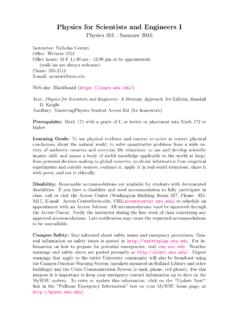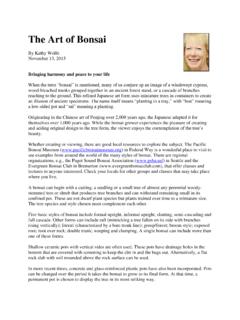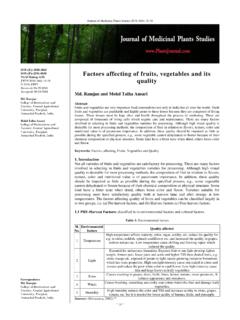Transcription of Bacterial Plant Pathogens - Washington State University
1 1 Bacterial Plant Pathogens AND SYMPTOMOLOGY Bacteria are microscopic prokaryotic (a cell in which the nuclear material is not enclosed by a nuclear membrane) and, for the most part, single-celled microorganisms. A single teaspoon of healthy topsoil contains about a billion Bacterial cells, 120,000 fungal cells and 25,000 algal cells. The genetic material of bacteria consists of a single DNA molecule suspended in the cells cytoplasm. Bacteria do not have a true nucleus as do animals, plants and fungi. Some bacteria also have small gene-carrying entities within their cytoplasm called plasmids. Plasmids are extra-chromosomal, self-replicating genes that are responsible for such characteristics as resistance to streptomycin, copper and other antibiotics.
2 Bacteria come in four shapes, there are coccus (spherical), bacillus (rod shaped) and spirochetes (spiral). Most phytopathogenic bacteria are rod shaped bacillus the only exception being Streptomyces (family Actinomycetes) which is a filamentous (thread-like, filiform) bacteria. Also, most of these bacteria have flagella which are whip-like structures projecting from a bacterium that functions as an organ of locomotion. Some species of bacteria have only one flagellum (monotrichous) or a tuft of two or more flagella at one end of the cell. These are called polar flagella. Other species will have flagella distributed over the entire surface of the cell. These are termed peritrichous flagella.
3 Of the over 15,000 identified species of bacteria most are saprophytic and are of great benefit in decomposing dead and rotting organisms thereby releasing their nutrients back into the environment. This is the most important roll that bacteria play in nature. Plants rely on nitrogen from the soil but cannot directly acquire it from the gaseous nitrogen in the atmosphere. The primary way nitrogen is supplied to plants is through the mineralization of organic material in the soil. However, nitrogen fixation by bacteria such as Rhizobium spp. and Cyanobacteria spp. is almost as important as mineralization, and is a primary source of nitrogen. As these bacteria metabolize they convert gaseous nitrogen into nitrates or nitrites that become available to plants.
4 Most phytopathogenic bacteria are aerobic (live in the presence of oxygen) and some are facultative anaerobes which can grow with or without oxygen. Some bacteria have thick, rigid cell walls which will retain dye from a cell staining method developed by Christian Gram, while other bacteria will not accept this stain. This method of staining results in the bacteria being classed as Gram-positive or Gram-negative and is an important factor in identification and classification. Gram-positive bacteria appear purple and Gram-negative bacteria appear pink under magnification. Bacteria are also distinguished by the different kinds of enzymes they either can or cannot use for nourishment and the nutrient media on which they can grow.
5 2 Rod shaped bacteria reproduce asexually by the process of binary fission (the transverse splitting in two of a Bacterial cell). This process takes place when the cytoplasmic membrane grows inward dividing the cytoplasm into two approximately equal parts. When the cell walls are completely formed the cell splits into two cells. During this process the nuclear material duplicates itself and becomes distributed equally between the two cells. Bacteria can reproduce at a very rapid rate; some species can divide every 20 minutes under ideal conditions. It is conceivable that a single bacterium could produce one million progeny in less than 24 hours. However, with limited food supply, environmental conditions and other factors the optimum conditions rarely occur in nature.
6 There are around 200 species of phytopathogenic bacteria and almost all of them are parasites within the Plant , on its surface, in Plant debris or in the soil as saprophytes. Dissemination of bacteria can be accomplished by several means. Some bacteria can survive on inanimate objects, in water or inside insects. It is important to know the survival characteristics of bacteria for effective management strategy and intervention in dissemination. Some species have the ability to move short distances in water on their own power by use of their flagella. Most bacteria, however, are disseminated by passive agents such as air and insects, water and soil movement, and to a lesser degree by humans, water and other animals.
7 Infected seeds and transplants can also be a source of inoculums. Most bacteria require a wound or natural opening ( stomata, lenticels or hydathodes) to gain entry into the host tissue and also require warm, moist conditions to establish a colony. Windblown soil and sand will commonly cause wounds which can facilitate Bacterial infections. Bacteria colonize a host by growing between the cells and absorbing the cells nutrients that leak into intercellular space or grow within the vascular tissue of the Plant . Depending on the species of bacteria and the tissue infected they produce and release enzymes that degrade cell walls, growth regulators that alter the plants normal growth, toxins that degrade cell membranes and complex sugars that plug water conducting tissue.
8 The following is a general classification (Agrios, 5th Ed, 2005) of phytopathogenic prokaryotes with the exception of the Division Tenericutes, Class Mollicutes, which will be addressed in a later section. Genera in bold type are common Plant Pathogens . Bacterial colonies on a nutrient medium Bacilliform bacterium 3 Kingdom: Procaryotae Bacteria Have cell membrane and cell wall and no nuclear membrain. Division: Bacteria Gram-positive Class: Proteabacteria Mostly single celled bacteria. Family: Enterobacteriaceae Genus: Erwinia, causing fire blight of pear and apple, Stewart s wilt in corn, and soft rot of fleshy vegetables. Pantoea, causing wilt of corn.
9 Serratia, S. marcescens, a phloem-inhabiting bacterium causing yellow vine disease of cucurbits. Sphingomonas, causing brown spot of yellow Spanish melon fruit. Family: Pseudomonadaceae Genus: Acidovorax, causing leaf spots in corn, orchids and watermelon. Pseudomonas, causing numerous leaf spots, blights, vascular wilts, soft rots, cankers, and galls. Ralstonia, causing wilts of solanaceous crops. Rhizobacter, causing the Bacterial gall of carrots. Rhizomonas, causing the corky root rot of lettuce. Xanthomonas, causing numerous leaf spots, fruit spots, blights of annual and perennial plants, vascular wilts and citrus canker.
10 Xylophilus, causing the Bacterial necrosis and canker of grapevines. Family: Rhizobiaceae Genus: Agrobacterium, the cause of crown gall disease. Rhizobium, the cause of nitrogen-fixing root nodules in legumes. Family: still unnamed Genus: Xylella, xylem-inhabiting, causing leaf scorch and dieback disease on trees and vines. Candidatus liberobacter, Phloem inhabiting, causing citrus greening disease. Unnamed, laticifer-inhabiting, causing bunchy top disease of papaya. Division: Firmicutes - Gram-positive bacteria. Class: Firmibacteria Mostly single celled bacteria.













